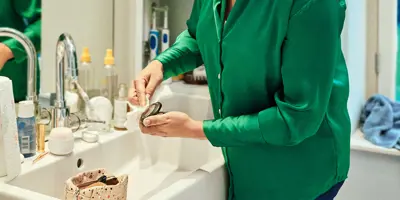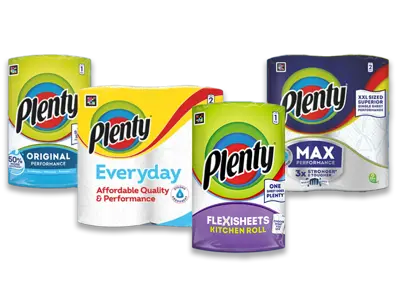5 people found this helpful
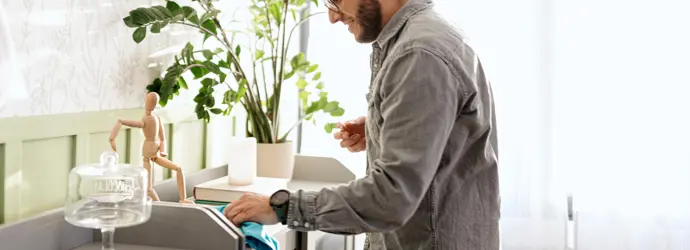
Dealing with the aftermath of an illness in the house – the trail of snotty, used tissues, and brown ring marks where cups of tea once steamed – can be a messy ordeal. Once you’re feeling better, though, (and not a second sooner!) you might want to start thinking about preventing the spread of any remaining germs in the house, to protect yourself and your loved ones. Read on for guidance on both deep cleaning the house and disinfecting the house.
Deep cleaning the house vs disinfecting the house: what are the differences?
You probably clean your house quite regularly, but did you know that when cleaning your home, deep cleaning and disinfecting the house are slightly different? Find out the differences between deep cleaning the house and disinfecting your home below.
Cleaning vs deep cleaning the house
What’s the difference between cleaning and deep cleaning your home? Deep cleaning, as the name indicates, goes further than regular cleaning. Where you’d hoover, dust, and wipe when cleaning, you’d mop, scrub, and clean every last inch of every last nook and cranny when deep cleaning.
Cleaning only removes dirt and impurities from regularly used surfaces. On the other hand, deep cleaning the house is more thorough, goes into every hidden corner of your home and takes more time than a regular clean. Get stuck into a deep clean and you might just stumble down mealtime memory lane... Remember that time a ladle full of tomato sauce flipped over and decorated the stove a new shade of ruby red? Now you know it wasn’t just the stove that was adorned with your lovingly made creation, but the back of the extractor fan, too!
Cleaning the house vs disinfecting the house
Now that we’ve clarified the differences between cleaning and deep cleaning the house, you probably want to know the difference between cleaning and disinfecting your house.
When you disinfect your house, you go one step further than just clean, as disinfecting is designed to kill bacteria and viruses on the surfaces, and is done with stronger bleach solutions or chemicals.1,2 While you can clean a house with natural products, you can’t fully disinfect it with them.
Disinfecting your house should be done reasonably, as there’s a risk that bacteria could develop a resistance if disinfectants are used too frequently and improperly.11 That’s why you shouldn't disinfect the house as regularly as you deep clean; it's something you would mostly do after someone’s been sick at home to reduce the presence of germs, or if you live with a person with a vulnerable health condition that needs extra protection.
Continue reading to learn how to deep clean the house and how to disinfect at home!
How to deep clean your house
Deep cleaning is a good idea when you want to get rid of stubborn dirt, upholstery stains – or the lingering confetti behind the sofa from last month’s party! To do so, proceed the same way you would with your regular house cleaning – we have articles on making an effective house cleaning schedule and on how to clean your house quickly and well to help!
Below, we’ll run through each room of the house and learn how to deep clean the house.
Deep cleaning the bathroom
Starting with the bathroom, follow our tips on how to deep clean the sink, toilet, and bathroom surfaces:
- Scrub the shower and sink. The stage is now set for your next shower-time pop star performance! Your adoring fans (also known as your housemates) can’t wait to tune in!
- Clean the drain, and don’t forget to remove hair to avoid any blockages.
- Remove limescale from your taps.
- Clean the shower corners to prevent and remove mould.
Deep cleaning the kitchen
Kitchen hygiene plays an essential role in keeping your loved ones safe and healthy.7 We have compiled a few ideas to help you deep clean your kitchen:
- Clean the hob. The hob is easy to forget during regular cleaning, so make sure to pay extra attention to its nooks and crannies during your home’s deep cleaning!
- Clean the oven and microwave. If you use your microwave and oven often, it’s important to keep them clean. Remember the mug cake fiasco of last winter? Your microwave does! Be sure to get into the corners to remove all traces of the chocolate cake-tastrophe. (It’s such a shame that you had to buy a double fudge chocolate cake from the shops instead...)
- Clean the fridge. Don’t forget about the fridge to ensure that your food is stored in a clean place!
- Descale the kettle. Has limescale accumulated at the bottom of your kettle? It’s time to take care of it! Follow our guide on how to descale a kettle.
- Wipe surfaces with a sanitising solution.
Tip
Deep cleaning... You just never know what you might find. Winner of Product of the Year 2024*, each roll has 250 sheets and is 50% longer**, so it’s best to have Plenty Flexisheets to hand. Whether you stumble across a few splashes of tea, or a stockpile of now-melted apple cores your little one was stashing behind the radiator, you’ll always have the perfect amount of kitchen roll.
Deep cleaning the bedroom and living-room
Here’s what to think about when doing a deep clean of a bedroom or a living-room:
- Mop the floor. You may hoover quite often, but if your floor isn’t carpeted, you can go the extra mile and mop for a really deep clean!
- Clean under the bed. Under the bed, or where odd, holey socks go to die (according to your partner)! Give it a good tidy – you might even match up a long-lost pair or two!
- Hoover curtains. Speaking of hoovering, a part that you don’t always think about hoovering is your curtains. Give your curtains some love during your home’s deep cleaning.
How to disinfect your house
Now that you know (almost) everything about a home’s deep cleaning, let’s learn how to disinfect the house to eliminate germs after someone’s been sick. Remember that disinfecting should not be done as regularly as deep cleaning, and should be done mainly when there’s a risk of contamination. It also implies using a stronger bleach solution or disinfecting products that contain chemicals, so always handle these with care and follow the instructions on the label.3
Find out how to disinfect the house below!
How to disinfect at home: the bathroom
Here’s how to disinfect the sink and your bathroom if someone has been feeling unwell in the house:
- Disinfect your toilet. Use toilet bleach for the toilet bowl, and a strong disinfectant that can kill bacteria and viruses for the toilet seat and flush.
- Disinfect high-touch surfaces such as the showerhead, and faucet with a disinfectant to avoid contamination. Opt for a Defra-registered disinfectant, which guarantees that the product meets disinfecting and safety standards.4
- Disinfect the sink and shower with an adapted disinfectant.
- Replace toothbrushes with new ones when bristles begin to wear. These can harbour bacteria and lead to potential contamination.5,6
Disinfect your home: the kitchen
Now, when it comes to kitchen disinfecting at home:
- Once again, focus on disinfecting high-touch surfaces. This includes stove buttons, kettle and cabinet handles, the refrigerator door, the biscuit tin lid...
- Take out the rubbish and make sure to disinfect the bin. Your waste can harbour bacteria and fungi, so it’s very important that you disinfect the bin it’s been sitting in to keep any vulnerable members of your household – such as young children, the elderly, and those living with long-term health issues – safe.8
- Sterilise dishes and utensils. Usually, a deep clean in the dishwasher or kitchen sink will be enough, but if a member of your household has been unwell, disinfection may be necessary. This can help minimise the spread of potentially harmful bacteria and viruses, which is especially important if there are members of your household more vulnerable to illnesses. You can do this by soaking them in boiling water for 10 minutes.9
Disinfecting your bedroom and living-room
Last but not least, our last tips are here to help you disinfect a bedroom and living room that have been exposed to germs:
- Disinfect high touch points (again!). Doorknobs and light switches should be wiped with a disinfecting product to get rid of bacteria and viruses.2
- If you have a bin in your bedroom, disinfect it, especially if it’s full of tissues from that cold that you caught and don’t want to spread...
- Make sure to keep temperatures and humidity at the right level to prevent mould from growing, and to ensure that the air quality is optimal to protect vulnerable people.
- Wash all clothes worn while being sick! Bacteria and viruses can survive on textiles for weeks, if not months, and could be a possible source of contamination.10
- Wash all bedsheets for the same reason as above. Just make sure you remind your partner to put the fresh set on after you’ve washed the dirty bedding. Slinking off to bed, only to find your sodden sheets are still in the washing machine is truly a modern tragedy!
You now know how to deep clean the house and how to disinfect the house! Deep cleaning regularly and disinfecting to prevent the spread of germs after you or someone in the house has been unwell, is an efficient way to care for the health of your loved ones. Look after vulnerable members of your household – think toddlers, elderly, people with weakened immune systems – by maintaining good hygiene habits and sanitising your house!
When you’re on your hands and knees, with a solid sweat on your brow, scrub-scrub-scrubbing away at that mystery stain in the bathroom, just remember – your loved ones, friends, housemates or carers are all going to do the same for you one day! That’s what having people to care for is all about: rolling up your sleeves and pitching in where it counts. That’s life, and we wouldn’t have it any other way.
*Winner General Household Category. Survey of 8,000 people in UK & ROI
**Length of roll when compared to Plenty Original
Sources:
1 Centers for Disease Control and Prevention, “When and how to clean and disinfect your home”
2 EPA.gov, “What’s the difference between products that disinfect, sanitise, and clean surfaces?”
3 Centers for Disease Control and Prevention, “Cleaning and disinfecting with bleach”
4 Gov.uk “Get your disinfectant approved by Defra”
9 North Dakota State University, “Disinfecting dishes, cookware and utensils”
Related articles
Air fryer cleaning: how to clean an air fryer
Learn how to keep an air fryer clean, how to clean your air fryer as well as other top air fryer cleaning tips with this handy air fryer cleaning guide.
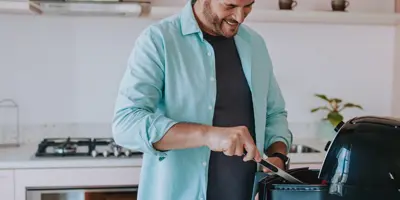
How to get pee out of a mattress and clean a wet bed in 10 steps
Has your child wet the bed? Don’t panic. Simply read our guide to learn how to remove urine from a mattress and clean a wet bed.
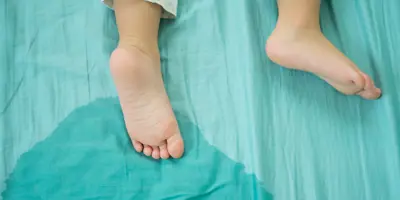
How to clean a TV screen: Plenty’s top tips for a sparkling clean TV
Discover the best way to clean TV screens with Plenty. Tired of a streaky, thumbprint-covered picture? Read how to clean a TV so it looks brand new!
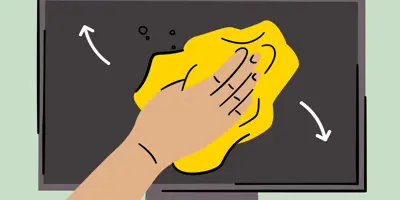
How to Clean Baby Toys & Disinfect Toys Covered in Goo
Being a parent involves many skills, like knowing how to sanitise baby toys! Find out how to clean soft baby toys, hard bath toys and teething toys here.

How to clean the washing machine seal when it's looking gunky
Cleaning a washing machine seal is boring but important! Learn about cleaning the rubber seal on a washing machine and how to prevent future gunkiness.
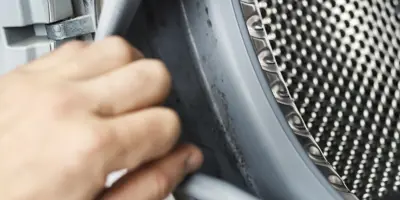
Gurgling sink? How to unclog a sink
Need to know how to unclog a sink? You’re in luck! Here you’ll learn about unclogging a sink with baking soda (a.k.a. bicarb) and with specialist cleaners.
